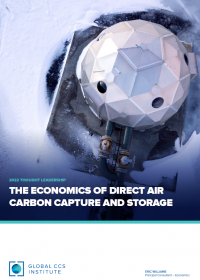Resources
Publications
Our publications, reports and research library hosts over 500 specialist reports and research papers on all topics associated with CCS.
View our Publication Library Disclaimer.
Filter by
The Economics of Direct Air Carbon Capture and Storage
26th July 2022
Topic(s): Carbon capture and storage (CCS), CO2 removals, Direct air carbon capture and storage (DACCS), Economics
Carbon capture and storage (CCS) is a set of technologies that capture CO2 from large emission sources or from the atmosphere and safely stores it underground or permanently in products. As the scale and urgency of climate action has become clearer in recent years and governments and companies have done the necessary work to map their own pathways to climate neutrality, carbon dioxide removal (CDR) technologies - direct air carbon capture and storage (DACCS) in particular - have become a focal point in climate mitigation.
This paper explores the economics of DACCS, relying on the economic model described in the methodology, in which actors within the energy system are free to pursue least-cost options in meeting net-zero pathways. The intent of the paper is a thought experiment to show how DACCS deployment might affect the global energy system. It focuses solely on the cost of DACCS - applying no additional policy assumptions - and is not a forecast.
The paper finds that:
- DACCS plays a unique role among technological climate mitigation options as it can function as a backstop technology, potentially avoiding climate disaster if other low-cost pathways are not realised.
- Low-cost DACCS, should it be realised, would reduce the total cost of decarbonisation and meeting climate goals.
- If DACCS deployment is limited due to high costs, the main decarbonisation pathway for industry and transport (except light duty vehicles, which are electrified) is hydrogen.
- Electricity generation, buildings, and light vehicles are largely unaffected by the deployment of DACCS and decarbonise through increased efficinecy and renewable energy pathways.
- The challenge inherent for governments is to implement policy and provide incentives for immediately available mitigation pathways, while supporting the development and commercialisation of lower-cost DACCS.
Download a description of the economic model used in this paper here.
Disclaimer
The content within the Global CCS Institute Publications, Reports and Research Library is provided for information purposes only. We make every effort and take reasonable care to keep the content of this section up-to-date and error-free. However, we make no claim as to its accuracy, currency or reliability.
Content and material featured within this section of our website includes reports and research published by third parties. The content and material may include opinions and recommendations of third parties that do not reflect those held by the Global CCS Institute.
